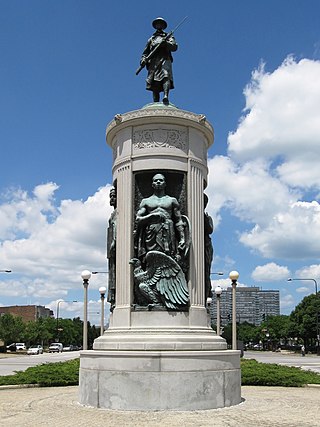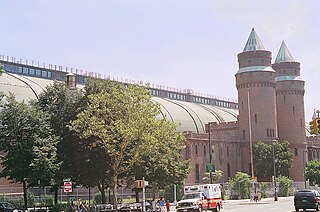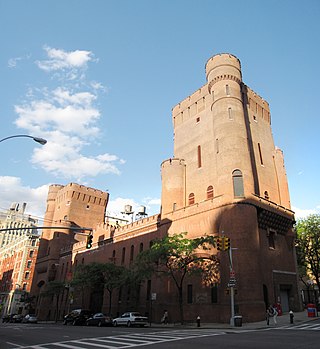
Illinois Institute of Technology, commonly referred to as Illinois Tech and IIT, is a private research university in Chicago, Illinois. Tracing its history to 1890, the present name was adopted upon the merger of the Armour Institute and Lewis Institute in 1940. The university has programs in architecture, business, communications, design, engineering, industrial technology, information technology, law, psychology, and science. It is classified among "R2: Doctoral Universities – High research activity".

The 369th Infantry Regiment, originally formed as the 15th New York National Guard Regiment before it was re-organized as the 369th upon its federalization and commonly referred to as the Harlem Hellfighters, was an infantry regiment of the New York Army National Guard during World War I and World War II. The regiment mainly consisted of African Americans, but it also included men from Puerto Rico, Cuba, Guyana, Liberia, Portugal, Canada, the West Indies, as well as white American officers. With the 370th Infantry Regiment, it was known for being one of the first African-American regiments to serve with the American Expeditionary Forces during World War I.

Douglas, on the South Side of Chicago, Illinois, is one of Chicago's 77 community areas. The neighborhood is named for Stephen A. Douglas, Illinois politician and Abraham Lincoln's political foe, whose estate included a tract of land given to the federal government. This tract later was developed for use as the Civil War Union training and prison camp, Camp Douglas, located in what is now the eastern portion of the Douglas neighborhood. Douglas gave that part of his estate at Cottage Grove and 35th to the Old University of Chicago. The Chicago 2016 Olympic bid planned for the Olympic Village to be constructed on a 37-acre (15 ha) truck parking lot, south of McCormick Place, that is mostly in the Douglas community area and partly in the Near South Side.

The Marquette Building, completed in 1895, is a Chicago landmark that was built by the George A. Fuller Company and designed by architects Holabird & Roche. The building is currently owned by the John D. and Catherine T. MacArthur Foundation. It is located in the community area known as the "Loop" in Cook County, Illinois, United States.

Erected in 1927, the Victory Monument, is a bronze and granite sculptural monument, based on a concept by John A. Nyden, and sculpted by Leonard Crunelle. It was built to honor the Eighth Regiment of the Illinois National Guard, an African-American unit that served with distinction in France during World War I. It may be the only memorial statue dedicated to African-American soldiers of the Great War.

The Chicago Defender Building, located at 3435 S. Indiana Avenue in the Black Metropolis-Bronzeville District of the Douglas community area of Chicago, Illinois, housed the Chicago Defender from 1920 until 1960. Designed by Henry L. Newhouse, it was originally a synagogue. The building was designated a Chicago Landmark on September 9, 1998.

The Black Metropolis–Bronzeville District is a historic African American district in the Bronzeville neighborhood of the Douglas community area on the South Side of Chicago, Illinois.

The Chicago Bee Building is a historic building on Chicago's South Side. It originally housed the Chicago Bee, a newspaper serving the African Americans of Chicago. The building now houses the Chicago Bee Branch of the Chicago Public Library. The building was named a Chicago Landmark on September 9, 1998. It is located in the Black Metropolis-Bronzeville District in the Douglas community area of Chicago, Illinois.

Wabash Avenue YMCA is a Chicago Landmark located within the Chicago Landmark Black Metropolis-Bronzeville Historic District in the Douglas community area of Chicago, Illinois. This YMCA facility served as an important social center within the Black Metropolis area, and it also provided housing and job training for African Americans migrating into Chicago in the early 20th century. In 1915, the Association for the Study of Negro Life and History, one of the first groups specializing in African-American studies, was founded during a meeting at the Wabash 'Y'.

Hygienic Manufacturing Company, also known as Overton Hygienic Company, was a cosmetics company established by Anthony Overton. It was one of the nation's largest producers of African-American cosmetics. Anthony Overton also ran other businesses from the building, including the Victory Life Insurance Company and Douglass National Bank, the first nationally chartered, African-American-owned bank. The Overton Hygienic Building is a Chicago Landmark and part of the Black Metropolis-Bronzeville District in the Douglas community area of Chicago, Illinois. It is located at 3619-3627 South State Street.

The South Side is one of the three major sections of the city of Chicago, Illinois, United States. Geographically, it is the largest of the three sections of the city, with the other two being the North and West Sides. It radiates and lies south of the city's downtown area, the Chicago Loop.

The Kingsbridge Armory, also known as the Eighth Regiment Armory, is a decommissioned armory at Jerome Avenue and West Kingsbridge Road in the Kingsbridge Heights neighborhood of the Bronx in New York City. It was built in the 1910s, from a design by the firm of then-state architect Lewis Pilcher to house the New York National Guard's Eighth Coast Defense Command, a regiment-sized unit which relocated from Manhattan in 1917. It is possibly the largest armory in the world.

The 369th Regiment Armory is a historic National Guard Armory building located at 2366 Fifth Avenue, between West 142nd and 143rd Streets, in Harlem, Manhattan, New York City. It was built for the 369th Regiment, also known as the "Harlem Hellfighters", founded in 1913 as the first National Guard unit in New York State composed solely of African-Americans. It later became home to the 369th Sustainment Brigade.

Chicago Military Academy-Bronzeville is a public four-year military high school located in the Bronzeville neighborhood located on the South Side of Chicago, Illinois, in a building known as the Eighth Regiment Armory. The academy opened on August 24, 1999. The academy includes a mandatory Junior Reserve Officers' Training Corps (JROTC) instructional component in addition to a four-year college preparatory curriculum.

The Media Armory, is a historic National Guard Armory located in Media, Delaware County, Pennsylvania built in 1908 for Company H of the 6th Infantry Regiment of the Pennsylvania National Guard.

The Squadron A Armory is a former United States Army armory and was the home base of Squadron A. It took up the whole block between Madison Avenue and Park Avenue, between 94th and 95th Street. It was therefore also known as the Madison Avenue Armory. A surviving part of the building is listed on the National Register of Historic Places as Madison Avenue Facade of the Squadron A Armory and is a New York City landmark.

The 14th Regiment Armory, also known as the Eighth Avenue Armory and the Park Slope Armory, is a historic National Guard armory building located on Eighth Avenue between 14th and 15th Streets in the South Slope neighborhood of Brooklyn, New York City, United States. The building is a brick and stone castle-like structure, and designed to be reminiscent of medieval military structures in Europe. It was built in 1891–95 and was designed in the Late Victorian style by William A. Mundell.

The 370th Infantry Regiment was the designation for one of the infantry regiments of the 93rd (Provisional) Infantry Division in World War I. Known as the "Black Devils", for their fierce fighting during the First World War and a segregated unit, it was the only United States Army combat unit with African-American officers. In World War II, a regiment known as the 370th Infantry Regiment was part of the segregated 92nd Infantry Division, but did not perpetuate the lineage of the 8th Illinois or World War I 370th, only sharing its numerical designation.
Wendell Campbell was an African American architect who studied under Mies Van Der Rohe and Ludwig Hilberseimer while attending the Illinois Institute of Technology. Campbell graduated in 1957 with a Bachelor of Arts in Architecture and City Planning, and after difficulty in finding work due to racial prejudice he founded his own firm in 1966. Campbell is noted for his contributions to several building projects throughout Chicago and Gary, Indiana as well as his redevelopment plans for major US cities. In 1971 Campbell co-founded and served as the first president of the National Organization of Minority Architects. In 1976 he was awarded the prestigious Whitney Young Medal of Honor by the American Institute of Architects (AIA) and designated as a fellow of the AIA in 1979.



















